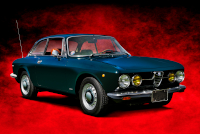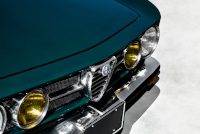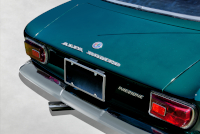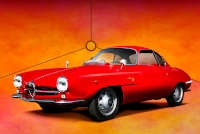Location:
St. Michaels Concours d'Elegance, 2021
Owner: Fred Zell | St. Michaels, Maryland
Prologue:
The 1750 GT Veloce crosses into mass market territory. And what is wonderful in this regard, the car sits close enough to modern history that we can use as a basis for our profile an actual road test.
These are among the late-model enthusiast cars that have surged recently for the pedigree of the marque, and wherever the word 'veloce' appears, special interest follows. So in the spirit of, "a rising tide lifts all boats," the GTV is one such tender.
- - - - - - - - - -
► Image Source: Nikon D750 (24.3 MP)
References:
- MotorSport Magazine: Marriott, Andrew. "The Alfa Romeo 1750 GTV" MotorSport, Volume XLIV, No.10, page 22-24. This most inspiring source can be read online, with more detail than we need retain.
- Hemmings: LaChance, David, "Tech: Spica Fuel Injection" Hemming's Motor News, April, 2013. A nice summary of the Spica mechanical fuel injection system.
- Wikipedia: Offers a nice description of the GT Veloce within the Tipo 105 production lineage.
- UltimateSpecs: We pull partly specifications from this entry, as it pertains to a carbureted version, and does not include detail on the platform or suspension.
- RM Auctions: A lovely 1969 car, carbureted, with Campagnolo wheels.
The enthusiast's choice, the Tipo 105 developed along the lines of the Giulia Sprint GT, Giulia Sprint GT Veloce, and their Giulia Sprint GTA counterparts. In fact, Alfa Romeo turned to the GTA program rather than develop the T-Zed program. Good as the TZ2 had been, the GTA's production-based design allowed Alfa Romeo to go racing in cars closely related to mass-production models, a strategy that also offered privateers greater opportunity to participate.
By 1967, the 1750 GT Veloce replaced the Giulia Sprint GT Veloce as the speedy coupe among a trio of new 1750 cars, rounded out by a berlina and a spider. Production volume increased, and the 1750 became mainstay competition for the Jaguar E-Type, Porsche 911, Lancia Fulvia, Lotus Elite, and BMW 02, enduring for seven years in 1750 GTV configuration, and a full decade with the subsequent 2000 GTV, (production of which overlapped the 1750).
As a late-model production car, (at least in the context of our portfolio), I find it tricky to measure the 1750 GT Veloce. These are cars that, perhaps a short while ago, could offer enthusiasts visceral satisfaction, a connection to the Alfa Romeo story, at a fraction of the cost. Those days are now gone. The quadrifoglio badging on the C-pillars is enough to excite the market.
Period style, classic Italian pods behind a beautiful wood-rimmed wheel, and Bertone written on the flanks, each feature emphasizes the 1750's kinship among the more illustrious racing houses of the post-War era. (To say nothing about the nostalgic 1750 moniker.) So while its value has always been roadholding and responsiveness, a GT Veloce might find itself as often on lawns than roads these days.
For a better judgment of what the 1750 GT Veloce is about, see the MotorSport review from 1968, referenced in the Resources section, which details an 1,100-mile trip through Ireland with the car. Most interesting is the report of an average 26 miles-per-gallon, accomplished while carrying three adults and luggage for the duration of the trip, including spirited driving.
Beginning in 1969, US-spec GT Veloce cars received Spica mechanical fuel injection, indicated by the 'Iniezione' script across the tail. In response to US emissions regulations, the Spica unit allowed Alfa to keep horsepower right about level with its European-spec carbureted cars. In the aftermarket, many owners converted fuel-injected cars to the European Weber 40DCOE carburetors. But, as the classics market grew and support increased for early fuel-injection systems, maintenance became less problematic, made worthwhile by scarcity of survivorship and the intrigue of running an early fuel-injected car.
Motor: 1,779 cc straight 4-cylinder, light alloy block and head | 80 mm x 88.5 mm | 9.0:1 compression
Valvetrain: DOHC, 2 valves per cylinder
Aspiration: Spica mechanical fuel injection
Summarized by Hemming's, the Spica unit is a miniature four-piston motor, belt-driven, mounted on the lower right side of the block. Fuel metering "is controlled by a mechanical computer, a three-dimensional cam and six centrifugal balls. The control unit adjusts for throttle angle and engine speed, and also compensates for changes in engine temperature and barometric pressure. It's a bit of mechanical wizardry that, once properly set up, seldom needs to be touched." Ingenuity, in other words.
Power: 122 bhp @ 5,500 rpm
Drivetrain: 5-speed gearbox, rear-wheel drive
Front Suspension: independent by double wishbones and coil springs with an anti-roll bar
Rear Suspension: live axle on coil springs located by lower trailing arms and an upper A bracket with an anti-roll bar
Architecture: pressed steel unitary construction
Kerb Weight: 1,038 kg (2,288 lbs)
Wheelbase: 2,350 mm (92.5 in)
Top Speed: 190 km/h (118 mph)
Etymology:
The term '1750' is vestigial, a nod to the classic 6C 1750—not quite so close to the actual capacity, (1,779 cc). 'GT' refers to the closed coupe configuration, following the Giulia Sprint GT Veloce, whereas 'veloce' itself means 'fast' or 'quick.' As with the GTA and GT Sprint, Bertone styled the coachwork. The community refer to the car as a 1750 GTV for short.
Figures:
The 1750 GT Veloce stepped into a seven-year production run that yielded roughly 32,000 units.
Three Boxes: The Italian Take on Three-Box Architecture
Not so much the stark three-box architectural exercise as its German counterparts, Alfa retains the classical elegance expected of an Italian GT. A simple panel crease circumnavigates the car, but creates a gentle bow along the shoulders, almost like an inverted leafspring. The bow ends in a tapered ducktail. These tail-below-nose proportions mimic Bertone's Sprint Speciale, an aesthetic meant to plant the tail neatly on the pavement while providing the nose a leaping attack at the wind—aerodynamic thinking, though greatly simplified by the close of the decade. High rear wheel arches cut into the aesthetic, but balance the profile.
Updated Fascia: Nose Evolution from the Giulia to the 1750
The 1750 reconfigured Alfa's Giulia nose, removing the venerated step-nose bonnet and trading two headlamps for four. The grille treatment is also the simplest of any similar Alfa GT produced before or after, with a single horizontal chrome bar bisecting the Alfa shield. These components look good, though not as well integrated as the Giulia. Clean, but less the classic than the Giulia.
US Spec: Identification for the Export Version
First series 1750 cars bound for the US write 'Iniezione' across the tail, whereas the later cars write the word across the boot lid. Also note there is no external latch for the boot. Alfa moved the latch to the passenger door jamb and included a locking mechanism. Clever, apart from its location opposite the driver. More substantial guards and seat headrests also distinguish this car among the European version. The radio antenna is non-standard, though not unheard of for retrofitted cars.
GT Interior: Notes on the 1750 GT Cabin
As a boy, my father described driving cars with gear levers mounted on the center dash console. He meant Alfas comparable to his 1971 240Z, which shared the vinyl dual-pod layout Italy made famous in the 1960s. Better, the wood trim in the Alfa Romeo and angled meters above the lever. More interesting, the slatted spokes in the steering wheel fit the horn buttons, (not so much buttons as blades), which is somewhat unexpected. As MotorSport wrote in 1968, the horn "is so effectively disguised that it took some considerable time to discover," whereas the design does make the GTV's steering wheel a highly specific artefact.
Also note that the 1750 receives a 5-speed gearbox, helpful for long, high-speed travel, and it is a true 2+2. In its day, the GTV offered enough pace, space, style, and economy to carry three adults and their belongings without sacrificing any of the enthusiasm that would make them enthusiasts to start with.
Last Updated: Mar 26, 2025








